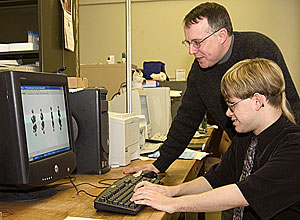|
Campus News
CNSE, Chemistry, RPI Team
Up with Wells
by Greta Petry (May
6, 2005)
 |
Doctoral
student Christopher Wells with his mentor,
chemistry professor John Welch. |
Christopher Wells, 26, a third-year doctoral
chemistry student from Lake George, N.Y., "likes
to boldly go where no one has gone before," to
paraphrase a line from "Star Trek."
That line describes Wells's approach
to using computational chemistry in nanosciences
research. "The existence of unexplored
areas in the nanosciences was the interest
for me," wrote Wells. "My mentor,
Dr. John T. Welch, (Department of Chemistry
chair and professor) helped me learn about
what there was in the nanosciences and where
it needed research for expansion."
Deaf from birth and legally blind, Wells
is accompanied by sign language interpreter
Donna Kosloske, who assists him in communicating
throughout the day.
Early in Wells's studies at UAlbany,
Alain Kaloyeros, president of Albany NanoTech
and vice president and CAO of the College of
Nanoscale Science and Engineering (CNSE), met
with him and encouraged him to join a collaborative
research program on molecular interconnects.
In this collaboration among CNSE Assistant
Professor of Nanoscience James Raynolds, Chemistry's
Welch, Rensselaer Professor of Chemical and
Biological Engineering Timothy S. Cale, and
Cale's post-doc "Ben" X.-Y.
Liu, Wells has been part of a productive inter-institutional
research effort.
"CNSE has made it possible for Chris
to work on research opportunities that would
not otherwise exist," Welch said. "The
cooperation of CNSE with RPI has provided Chris
with a rich educational experience."
The research on which the team works was
supported by the Microelectronics Advanced
Research Corp., the Defense Advanced Research
Projects Agency, and the New York State Office
of Science, Technology, and Academic Research
through the Interconnect Focus Center at UAlbany
and the Materials, Structures, and Devices
Center.
Cale brings his research discussion group
to Wells; both Cale and Raynolds have spent
many hours with him and are heavily invested
in his success. Liu, Raynolds, Wells, Welch,
and Cale were co-authors on the paper "First-Principles
Modeling of Electronic Transport in p Stacked
Molecular Junctions," which was submitted
to Applied Physics Letters.
In addition to being co-author of several
current manuscripts, Wells has been a part
of others already in print.
While he was starting high school, Wells
noted, "chemistry attracted me like a
moth to the lamp." Today, "my support
for this interest is nature itself and the
great chemistry department at the University
at Albany." Wells completed his undergraduate
work at Siena College, and switched from UAlbany's
master of science program to the doctoral program
at the end of last year.
"University at Albany has several factors
that were alluring to me, particularly its
long experience with students who have disabilities," he
wrote in a recent e-mail.
As a computational chemist in the group,
Wells deals with theoretical calculations of
chemical systems. These calculations apply
the ideas of quantum mechanics to give
powerful predictions about how model systems
should work, and are often effective in comparative
analyses against experimental work with actual
chemicals.
Kosloske, who lives near Wells, drives him
to Albany from his home in Lake George every
day. Wells uses the hour-long ride to read
and study, and said he has missed only one
class day due to an ice storm.
Many of the disabilities Wells handles today
are the result of his premature birth and 2
lb., 2 oz. birth weight. He has been on a liquid
diet since birth because of problems swallowing.
Adopted when he was almost 8, Wells lists his
extended family, including his adoptive mother,
a registered nurse, as "a significant
support system." He added, "I enjoy
the big brother role," as he has a 13-year-old
brother who was adopted from Romania and who
is also deaf.
Wells's home computer is equipped with
the same programs found in his lab, and Cale
has made it possible for him to have remote
access from home to Rensselaer's computer
facilities.
"I also sometimes modify some of the
equipment so it will work with my visual problems.
To deal with my communication issues due to
deafness and lack of voice, I use the Internet
to communicate with other people while at home," Wells
noted.
On campus, Director of Disabled Student Services
Nancy Belowich-Negron assists. Belowich-Negron
said, "Chris is a striking example of
what a brilliant student who happens to have
significant disabilities can do when reasonable
accommodations are provided and artificial
barriers are eliminated. We are fortunate to
have a high-caliber student like Chris in our
program and we are very pleased that his disability
needs are being met so that he can concentrate
on being a student/scientist."
Wells won a Disabled Student Services award
in April. His long-range goal is to be a computational
chemist.
"People at the University at Albany and
at RPI are making a significant effort to facilitate
Chris's education," Welch concluded. "They
are determined to help him succeed."
|
